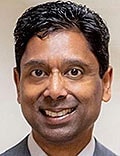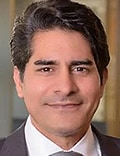Joseph Alisch took a gap year after his third year of medical school to do research on clustered regularly interspaced short palindromic repeats gene editing at the National Institutes of Health (NIH) as part of the Medical Research Scholars Program. In early 2025, he began to experience some of the research cuts at the NIH. While he got to do research in his area of interest, pediatric neurology, some of the cuts and other policy changes dampened his experience.
The first was a travel ban, which prevented him from attending the conference where he had planned to present his research findings. He was ultimately able to present virtually, “though it was never quite the same experience, because you like to go there and interact with all the people,” he said.
Next was a pause on purchasing laboratory products, which was problematic for him because his research required a variety of reagents.
“And so, for a while we kind of had to ration things,” he said. Then things became even more difficult. “So, there were moments we’re like, ‘Okay, we can purchase things.’ And then that policy was pulled back, saying, ‘Actually, we can’t purchase things right now.’”
He recalls thinking, “I just don’t know what’s going to happen, but I hope for the best and that we can continue working on these projects with minimal disruptions.”
But the shifting policies and delays ultimately interfered with his research.
“I was able to come out with something towards the end, but not the end product that I had envisioned when I did, when I started that gap year,” he told Medscape Medical News.
Many premed and medical students pursue research opportunities to bolster their applications to medical school or residency. However, based on the current national landscape, these opportunities are now more limited.
This year, the Trump administration made policy changes that limited federal research funding. For example, NIH capped reimbursement for indirect research expenses such as lab maintenance and operations at 15% for current and new grants. Comparatively, average indirect funding reported by NIH generally ranged between 27% and 28%.
In announcing the cap in February, NIH said in a statement on its website that, “Although cognizant that grant recipients, particularly ‘new or inexperienced organizations,’ use grant funds to cover indirect costs like overhead, NIH is obligated to carefully steward grant awards to ensure taxpayer dollars are used in ways that benefit the American people and improve their quality of life.”
The statement went on to say that many private foundations that fund academic research provide substantially lower funding for indirect expenses, yet “universities readily accept grants from these foundations.”
The idea, the statement said, is “the United States should have the best medical research in the world. It is accordingly vital to ensure that as many funds as possible go towards direct scientific research costs rather than administrative overhead.”
Medscape Medical News reached out to the White House Office of Science and Technology Policy for comment on how the Trump administration’s policy changes and federal funding cuts may affect medical trainees. The office did not respond.
Several state attorneys general, higher education associations, and research universities have filed lawsuits in protest. A US district judge blocked the 15% cap. However, the Trump administration appealed, and the fate of the policy remains in flux.
Some Physician Researchers Are Nervous
“NIH has been very steady and very reliable, in fact much more reliable than industry funding…,” said Srihari S. Naidu, MD, an interventional cardiologist and professor of medicine at New York Medical College in Valhalla, New York. “This is the first time where…we’re all on edge that money may not come through.”

Overall, “this is the kind of thing that will have…downstream consequences that affect the health of our country because these new discoveries and the research are what have evolved health care,” said Bobby Mukkamala, MD, president of the American Medical Association.
The government is probably trying to save money, but how they’re doing it is “very drastic,” Naidu said. And in his view, the consequences may be chilling for students interested in doing research.
“We know that a lot of graduate programs, as well as programs that fund research opportunities for medical students, have had delays in or cuts in funding,” added Kenira Thompson, PhD, MBA, director of research at Ponce Research Institute in Ponce, Puerto Rico. “And that’s resulted in, particularly in graduate programs, either delayed or limited new admissions because there are reduced funding pipelines.”
Students will still get into medical school, Naidu said, but there’ll just be fewer research opportunities.
“And if you have less research opportunities for them, you have a workforce that is less savvy about research and…with less abilities towards research, which ultimately limits…their options as a career,” Naidu said.
“…And then you’ll also have less innovation in that field because there’s less minds, less brainpower in that field doing research,” he said.
And there are probably more cuts to come. In President Trump’s proposed 2026 budget, NIH faces a budget cut of almost $18 billion, or about a 40% cut in funding.
According to reporting by The New York Times, a new analysis by the American Association for the Advancement of Science found that President Trump’s budget proposals for fiscal year 2026 include a 34% drop in basic science research from $45 billion to $30 billion and a 22% drop for overall science funding from $198 billion to $154 billion.
“The bottom line is that yes, everything is trickling down to impact students,” Thompson said.
Implications for Medical Trainees
“The students are going to see either reduced [research] slots or an increase in the competition for the slots that are available,” Thompson said. “Certainly, if the students don’t have sufficient research under their belt, then potentially it will limit their possibility of getting into a medical program.”
Naidu is also worried that the quality of research opportunities will suffer. What are the other options? There are registries that students can learn to use for research, but this is not going to be on the same magnitude or caliber as basic science research or clinical research, he said. “It won’t be clearly as innovative because the innovative thing takes a lot of money.”
Research Options in New Reality
A research vacuum could form where philanthropy, private equity, and industry players may “pour more money to make up the difference.” However, this increase in profit-driven research would create its own set of problems, Naidu said.
One is that this type of research has a bias in favor of trying to prove something.
“And number two, all the money goes towards things that can be commercialized rather than things that might be important,” he said.
For example, in his field of interventional cardiology, “if you have a new stent, industry just wants to prove that the new stent is better than the old stent. But we might want to know if no stents are better than having a stent altogether… And an industry that makes stents is not going to do a trial about whether it’s better to not have stents at all.”
“NIH is where you go when you need money to [address] the real important questions that society needs to know,” Naidu said. For example, interventional cardiologists may want to know which is better: stents vs bypass surgery, and stents vs medical therapy. “Most of those big trials are done through NIH funding.”
Given the new research realities, medical students and residents may have to consider research that is industry- or private-equity-sponsored, if those options are even available to them, Naidu said.
Most of the industry research doesn’t usually use medical students, residents, or fellows “because they’re tightly controlled,” he said.

If the research you do is private sector-driven — based on the research agenda of a particular company that needs to focus on getting a particular medication out the door to the market as opposed to you being in a research setting where there’s more independence, where you can do a deep dive into new discoveries and new ideas and sort of build on innovation — then certainly there will be an impact down the line,” Thompson said.
Naidu and Thompson also envision some premed and medical students seeking research opportunities abroad. “The greatest concern is that…there will be great inequity in terms of the opportunities available to students and that some really great students may be sort of left behind,” Thompson said.

Naturally, some students will pursue a research opportunity in other countries, Mukkamala said, but “there’s a huge expense to that as a medical student as if medical school isn’t expensive enough….”
“But then, trying to figure out how am I going to get to Germany, as in this example, to collaborate with people whose funding isn’t threatened on the exact same topic that I could have done here in my backyard.”
Advice to Medical Students
Naidu wants medical students to know that research is still a very valuable pursuit, “both in terms of helping you get to the next stage of your career, but also in and of itself, because it might stimulate you to go into a field of research, (in) a fabulous field that can allow you to be part of scientific progress in the world.”
But with decreasing funding opportunities, students may need to “cast their net wider,” he said, and be open to different topics than they might not have considered.
Naidu is trying to do his part to help with providing research opportunities. He created the Medical Research Fund at Brown University School of Medicine, his alma mater in Providence, Rhode Island, to support summer research opportunities for three medical students per year.
Students may also want to ask at interviews about the status of grant funding in a given lab they’re interested in working in, Mukkamala said.
“There’s less opportunities, but the best and the brightest will be able to find opportunities to still do research and…learn about the process and be competitive to move on in their careers,” Naidu said. “But it’s going to be a little harder because overall there’ll be less opportunities in total.”
“…This is a time in history we’re making major cuts to something that has been sustainable for a long time, Naidu said, adding later, “We would be basically going back 30 years in terms of research funding.”
Alisch, now a fourth-year medical student at Brown University School of Medicine, is taking a wait-and-see approach.
Despite the delays he experienced as a researcher at NIH during his gap year, Alisch said he was still quite hopeful about his future as a medical science researcher.
We are only about 6-7 months into this, he said. “We have a lot more time to go through before we can see how this is actually going to play out.”


 Admin_Adham
Admin_Adham


